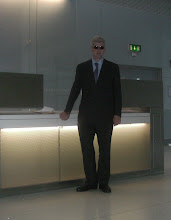 DARPA engineers have not yet been able to pinpoint what exactly went wrong during the first flight, which took place in April last year, and some have speculated that the craft ‘got too hot’.For its second mission a number of adjustments have been made including altering the centre of gravity and lowering the angle of descent. DARPA is planning to take second by second readings that will enable it to advance the project further.
DARPA engineers have not yet been able to pinpoint what exactly went wrong during the first flight, which took place in April last year, and some have speculated that the craft ‘got too hot’.For its second mission a number of adjustments have been made including altering the centre of gravity and lowering the angle of descent. DARPA is planning to take second by second readings that will enable it to advance the project further. Dave Neyland, director of DARPA’s Tactical Technology Office, said: ‘DARPA looks forward to conquering more unknowns about long-duration hypersonic missions. ‘We need to increase our technical knowledge to support future hypersonic technology development.‘We gained valuable data from the first flight, made some adjustments based on the findings of an engineering review board to improve this second flight, and now we’re ready to put all of that to the test.’The Falcon’s first flight had collected data about aerodynamics, how heat affects the craft and navigation.It also provided the first time that a real-life Mach 20 flight could be studied outside of a lab.‘Assumptions about Mach 20 hypersonic flight were made from physics-based computational models and simulations, wind tunnel testing, and data collected from HTV-2’s first test flight—the first real data available in this flight regime at Mach 20,’ said Air Force Major Chris Schulz, the Falcon programme manager.
Dave Neyland, director of DARPA’s Tactical Technology Office, said: ‘DARPA looks forward to conquering more unknowns about long-duration hypersonic missions. ‘We need to increase our technical knowledge to support future hypersonic technology development.‘We gained valuable data from the first flight, made some adjustments based on the findings of an engineering review board to improve this second flight, and now we’re ready to put all of that to the test.’The Falcon’s first flight had collected data about aerodynamics, how heat affects the craft and navigation.It also provided the first time that a real-life Mach 20 flight could be studied outside of a lab.‘Assumptions about Mach 20 hypersonic flight were made from physics-based computational models and simulations, wind tunnel testing, and data collected from HTV-2’s first test flight—the first real data available in this flight regime at Mach 20,’ said Air Force Major Chris Schulz, the Falcon programme manager.
‘It’s time to conduct another flight test to validate our assumptions and gain further insight into extremely high Mach regimes that we cannot fully replicate on the ground.
In America there still testing a substitute for the space shuttle with the X 37 still flying into space as a paying passenger seems to elude the visionaries. This reality could be made simple with a modified concord



No comments:
Post a Comment